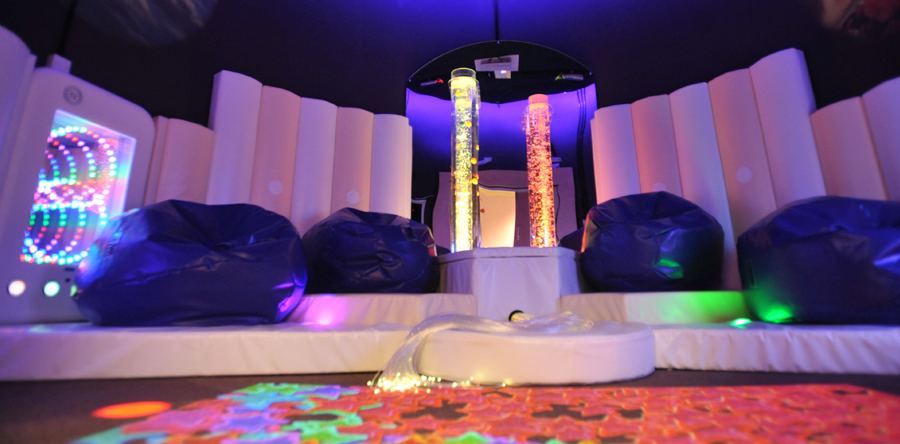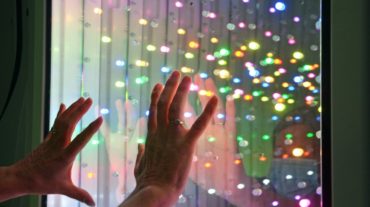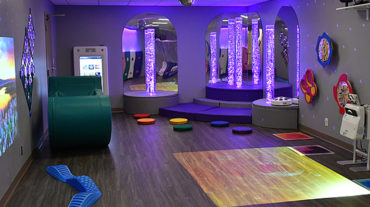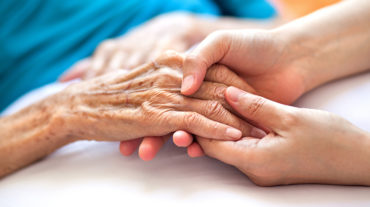What is Snoezelen MSE®?
Snoezelen, pronounced “snooze-uh-len,” roughly translated from Dutch, means "to explore and relax." It is a therapy for people with special healthcare needs such as brain injury, cerebral palsy, autism and many others. The Snoezelen environment is non-threatening, allowing users to overcome inhibitions, enhance self-esteem, and reduce tension. Research has shown that multi-sensory environments offer a wealth of benefits, often giving the participant and caregiver “an opportunity to improve communications, enhance their understanding of each other, and build trust in their relationship.”
In a world that is filled with sensory stimuli, most people’s brains learn to interpret and respond to information received via our senses. Eventually, sensory responses become organized, automatic, and efficient. Unless it is different or unusual, we tend to ignore much of the sensory stimuli that we absorb. At the same time we constantly regulate our sensory lives through choices, movements, and activities. We interpret, respond, react, and cope according to many different factors such as cognitive ability, culture, experience, and mood.
On the other hand, there are individuals who are unable to organize and respond appropriately to sensory stimuli. For those who have lost skills due to accident or illness, there is a lack of the ability or freedom to make choices to balance their sensory lives. Snoezelen MSE (Multi Sensory Environments) look to provide a relaxed atmosphere with pleasant surroundings, soothing sounds, captivating aromas, tactile experiences, massage and vibration, and more. Light effects and comfortable seating allow its users to self-regulate by choosing sensations. Snoezelen MSE incorporates a specialized selection of sensory equipment and materials that may help clients adapt their responses to sensory stimulation and to advance education and therapy goals. Each environment is customized to meet the needs of specific populations, and according to age and ability.
FlagHouse’s management first encountered Snoezelen during visits to Europe in 1991. Barbara McCormack (now a FlagHouse vice president) had discovered that her severely challenged, blind, young daughter actually had some vision in a Snoezelen setting. During succeeding visits, FlagHouse staff witnessed the extraordinary potential of Snoezelen to have a positive impact on the lives of people with disabilities. Eventually, the company signed an exclusive distribution agreement for North America with ROMPA International, the owners of the Snoezelen trademark.
What takes place in a Snoezelen Room?
Susan McKinley from Tangible Alternatives (TA), describes a typical session in a Snoezelen room for her clients. TA see between three to 10 clients in a typical day. The day could start with a sensory session for a male teenager with autism who comes for a combination of body work and sensory relaxation. He is working on self-awareness and relaxation. The room is set up with minimal lighting, a bubble tube, and the star projector. Because he is sensitive to music, he chooses if we play music or not. Some of his favorite materials are available, and he will dress up and often stage dramatic plays with the staff during his time. He is very aware and will help end his own session by starting to put away materials. The staff then cleans the equipment and readies the room for the next client after he transitions out.
Another client is an adult with cerebral palsy. The goal of her time is relaxation and communication, with a break from routines at her group home. She is minimally verbal, but has strong preferences that she lets staff understand by eye contact and voicing. She comes to the session with a group home staff and is met at the door by two TA staff members. McKinley says, “We make them all feel welcome and encourage her staff to relax while she does. Some weeks she will choose to swing. We have a large swing that she can lay on. Whenever she does, it is a two people assists in the transfer to the swing.”
Prior to the client’s session, TA staff members lay down where she will and, by trial and error, work on the lighting. She has very limited range of motion and will use her elbow to interact with the materials. She chooses if she wants music, and how loud she wants it. A favorite is the “Big Chill” soundtrack. She likes it loud. TA attendants run it through an iPod. Client also enjoys the iPod’s “Fish Pond” app. She splashes with her elbow and we project it on the wall so she can see the fish.
Other materials that are preferred are projectors that have liquid motion, bells and lifts that hang from the swing that she can ring and move with her arm, and a vibrating mat. During some sessions, this client wants her shoes off and lotion applied. Some weeks she wants her shoes on. A session lasts 30 minutes. One transitions the end by turning on lights and putting her shoes on. Then there is a discussion of about what she wants the following week. She is given enough time to respond. The session ends with the room being fully lighted, ambient lights off , and her being sat back in her chair. If she chose to use iPad or iPod, TA staff members take the device to the door while the client’s own staff gets the lift ready.
Closing up, the room is cleaned and materials wiped off. TA staff members routinely share what works, with caregivers, and keep notes about preferences for future use.•
Originally published in Exceptional Parent Magazine: November 2012
Download article as PDF





